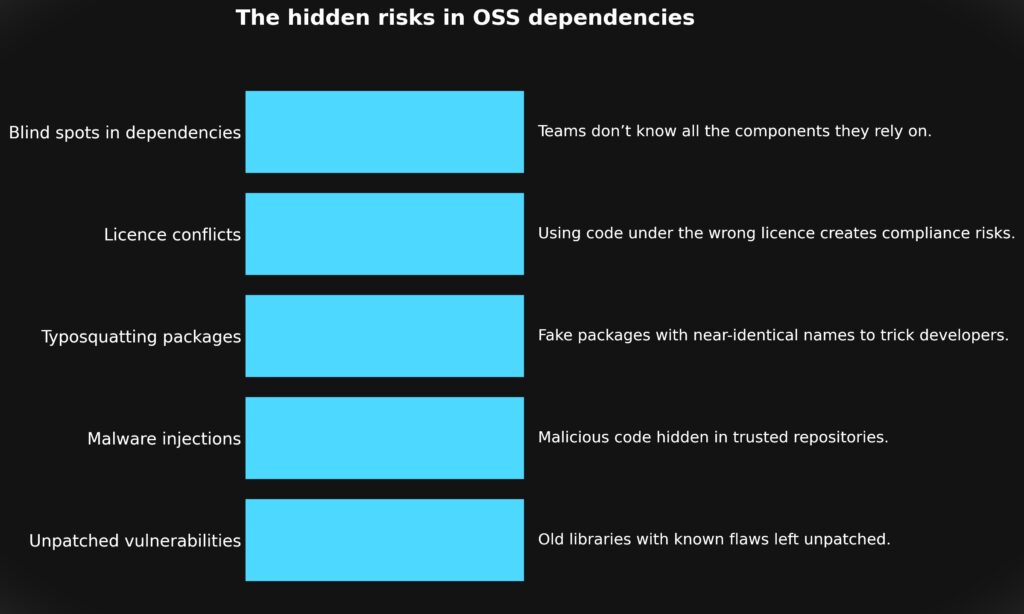
OSS Security: Building Trust in the Open-source Supply Chain
One tiny bug. One missed update. That’s sometimes all it takes for the digital world to stumble. Think back to the Log4j chaos; it spread faster than most teams could react. Open source turned from invisible plumbing into front-page news overnight. That moment proved something important: open source is both a blessing and a blind spot.
From the apps on your phone to the money in your bank, and yes, even the plane you just boarded, it’s everywhere. Yet how often do we stop to ask: who’s really watching the code we trust every single day?
That’s where OSS security comes in, not as a “nice-to-have,” but as the foundation of digital trust. And in this piece, we’ll take a deep dive into how it works, the risks it carries, and the tools that help keep it safe.
What is OSS and how does it work?
Open-source software, or OSS, is basically code that anyone can pick up, use, and even improve. It’s built by communities of developers spread across the world, sharing libraries and frameworks that others depend on every single day.
Most teams don’t start from scratch anymore. Why would they? It’s far quicker to plug in existing components and move forward. That shortcut saves money, trims timelines, and gives developers room to focus on new features instead of reinventing old ones.
But here’s the trade-off: simplicity up front, complexity underneath. Modern apps aren’t carefully handwritten line by line. They’re stitched together, often from hundreds of pieces written by people you’ll never meet. And the risk is evident if one of those pieces is weak; the entire system can feel the impact. That interdependence is what makes OSS so powerful, and so fragile at the same time.
Where does OSS really hide?
Open source is powerful, but it isn’t risk-free. The more dependencies you add, the harder it becomes to see what’s really inside your software. That blind spot leaves room for attackers, and history shows they’re quick to take advantage. Here are the most common risks teams face:

Ignoring these risks doesn’t make them go away; it simply leaves organisations more exposed when the next attack comes.
Tools that strengthen OSS security
Every new dependency adds risk. That doesn’t mean teams should stop using open source—it means they need better ways to manage it. The good news? A strong ecosystem of software supply chain security tools now makes that possible.
- SBOM generation tools: Think of these as ingredient labels for software. They show exactly what’s in your application. Using standards like SPDX and CycloneDX, they make it easy to check if you’re affected when a new vulnerability appears.
- Vulnerability scanners: Tools like Trivy, Grype, and Snyk constantly compare your dependencies against databases of known flaws.
- Policy enforcement tools: These go beyond detection. They block unsafe or unverified packages before they ever reach production.
- Threat intelligence feeds: By connecting to global data sources, they alert teams to suspicious behaviour in open source repositories.
- Remediation platforms: Instead of leaving developers with just a warning, they suggest safer versions or alternatives, turning “here’s the problem” into “here’s the fix.”
Together, these tools shift OSS security from guesswork to something structured and proactive. Used well, they let teams innovate quickly without constantly looking over their shoulders.
Lessons from recent attacks
These high-profile incidents show what happens when OSS security isn’t prioritised:
| Year | Incident | What happened | How tools could have helped |
| 2018 | Event-stream | Attackers hijacked a Node.js package and injected malicious code, affecting thousands of apps. | Policy enforcement + vulnerability scanning |
| 2021 | Codecov breach | Attackers tampered with a testing tool and quietly siphoned sensitive data. | SBOM + real-time monitoring |
| 2021 | Log4j flaw | A bug in a logging library triggered worldwide panic and weeks of patching. | SBOM + scanners for rapid detection |
Each of these wasn’t just a glitch, it was proof that unchecked OSS dependencies can spiral into global problems. They also show how the right tools could have reduced the damage, if not prevented it entirely.
The regulatory push
Governments have noticed too. In the United States, federal contractors must now provide SBOMs. The European Union’s Cyber Resilience Act goes even further, enforcing stricter requirements for software security. And groups like the Linux Foundation are publishing frameworks to guide organisations through the maze of OSS risk. This means OSS security isn’t just good practice, it’s becoming law. Teams that move early will find compliance easier and gain a competitive edge.
Distilled
Open source has given us speed and freedom that older models of software could never match. But those gains come with strings attached. All it takes is one overlooked dependency to crack an otherwise solid system. The smarter path is to stay ahead: use SBOM generation tools, scan continuously for weak points, and bring open-source supply chain risk management into everyday practice. That way, teams can keep building fast without gambling on safety.
In the end, OSS security isn’t a nice add-on. It’s the guardrail that keeps innovation moving without collapsing under its own weight. And as software supply chains grow ever more complex, that guardrail will only become more important.